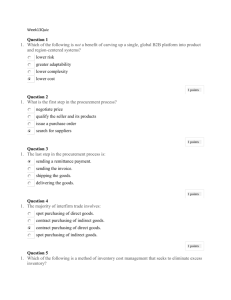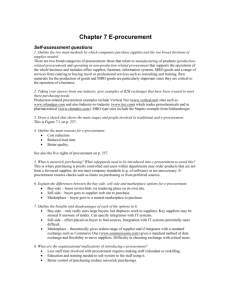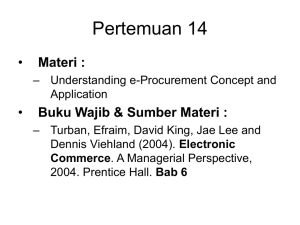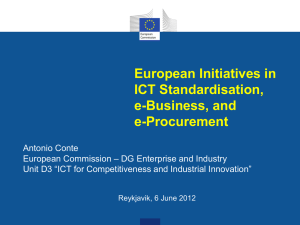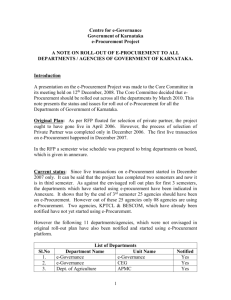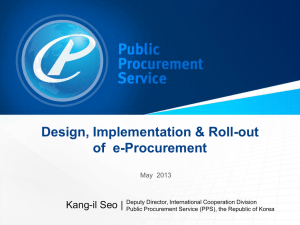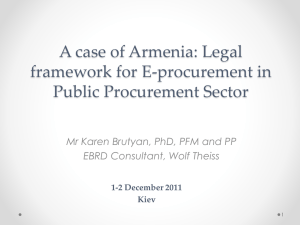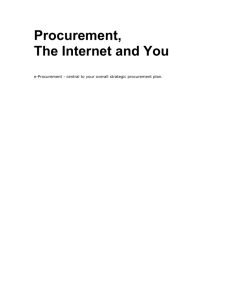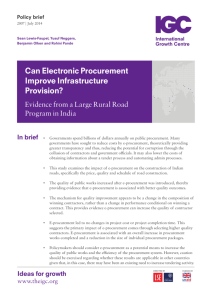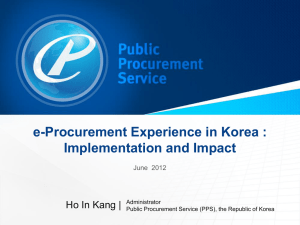e-Procurement and Online Marketplaces
advertisement
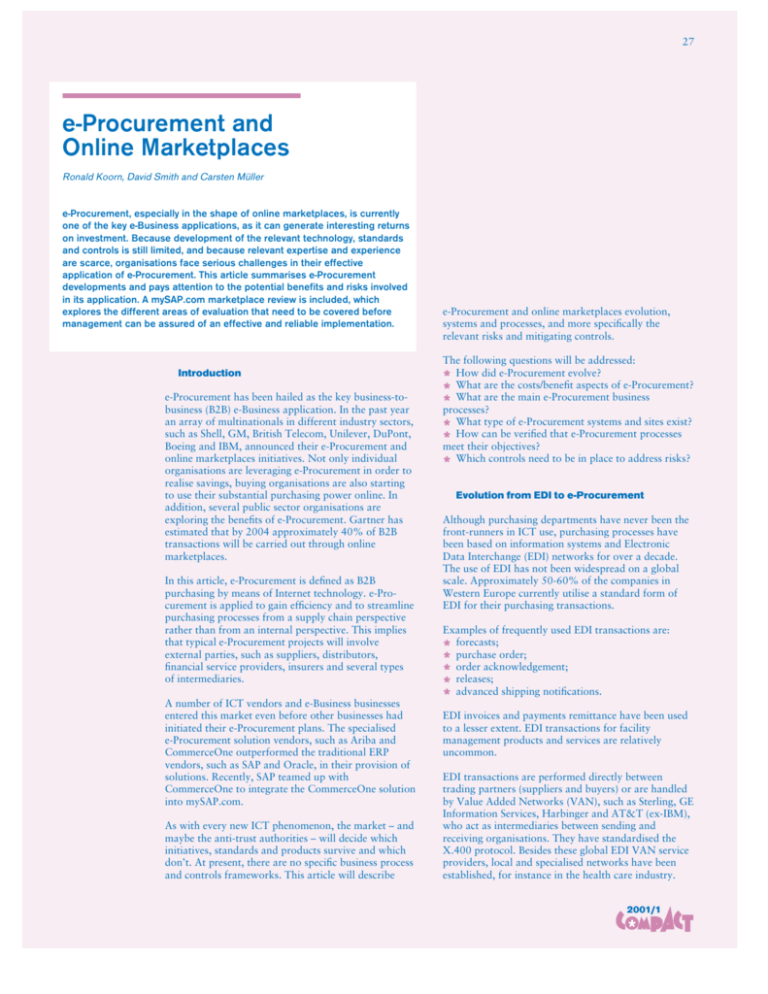
27 e-Procurement and Online Marketplaces Ronald Koorn, David Smith and Carsten Müller e-Procurement, especially in the shape of online marketplaces, is currently one of the key e-Business applications, as it can generate interesting returns on investment. Because development of the relevant technology, standards and controls is still limited, and because relevant expertise and experience are scarce, organisations face serious challenges in their effective application of e-Procurement. This article summarises e-Procurement developments and pays attention to the potential benefits and risks involved in its application. A mySAP.com marketplace review is included, which explores the different areas of evaluation that need to be covered before management can be assured of an effective and reliable implementation. Introduction e-Procurement has been hailed as the key business-tobusiness (B2B) e-Business application. In the past year an array of multinationals in different industry sectors, such as Shell, GM, British Telecom, Unilever, DuPont, Boeing and IBM, announced their e-Procurement and online marketplaces initiatives. Not only individual organisations are leveraging e-Procurement in order to realise savings, buying organisations are also starting to use their substantial purchasing power online. In addition, several public sector organisations are exploring the benefits of e-Procurement. Gartner has estimated that by 2004 approximately 40% of B2B transactions will be carried out through online marketplaces. In this article, e-Procurement is defined as B2B purchasing by means of Internet technology. e-Procurement is applied to gain efficiency and to streamline purchasing processes from a supply chain perspective rather than from an internal perspective. This implies that typical e-Procurement projects will involve external parties, such as suppliers, distributors, financial service providers, insurers and several types of intermediaries. A number of ICT vendors and e-Business businesses entered this market even before other businesses had initiated their e-Procurement plans. The specialised e-Procurement solution vendors, such as Ariba and CommerceOne outperformed the traditional ERP vendors, such as SAP and Oracle, in their provision of solutions. Recently, SAP teamed up with CommerceOne to integrate the CommerceOne solution into mySAP.com. As with every new ICT phenomenon, the market – and maybe the anti-trust authorities – will decide which initiatives, standards and products survive and which don’t. At present, there are no specific business process and controls frameworks. This article will describe e-Procurement and online marketplaces evolution, systems and processes, and more specifically the relevant risks and mitigating controls. The following questions will be addressed: How did e-Procurement evolve? What are the costs/benefit aspects of e-Procurement? What are the main e-Procurement business processes? What type of e-Procurement systems and sites exist? How can be verified that e-Procurement processes meet their objectives? Which controls need to be in place to address risks? * * * * * * Evolution from EDI to e-Procurement Although purchasing departments have never been the front-runners in ICT use, purchasing processes have been based on information systems and Electronic Data Interchange (EDI) networks for over a decade. The use of EDI has not been widespread on a global scale. Approximately 50-60% of the companies in Western Europe currently utilise a standard form of EDI for their purchasing transactions. Examples of frequently used EDI transactions are: forecasts; purchase order; order acknowledgement; releases; advanced shipping notifications. * * * * * EDI invoices and payments remittance have been used to a lesser extent. EDI transactions for facility management products and services are relatively uncommon. EDI transactions are performed directly between trading partners (suppliers and buyers) or are handled by Value Added Networks (VAN), such as Sterling, GE Information Services, Harbinger and AT&T (ex-IBM), who act as intermediaries between sending and receiving organisations. They have standardised the X.400 protocol. Besides these global EDI VAN service providers, local and specialised networks have been established, for instance in the health care industry. 2001/1 2001/1 28 Table 1. EDI advantages and disadvantages. Aspect EDI advantages EDI disadvantages Business processes Automating process and redundancy of paper forms. Due to system interfaces, no end-to-end optimisation. Limited integration with payment processes and systems. Limited real-time transactions due to store-and-forward principle. Usage Limited to selected staff in EDI or connected ERP/back-office systems. Few EDI systems or interfaces per organisation, no overall access. No catalogues or multi-media information. Standardisation Message standardisation for most industry sectors. Several competing VANs to connect with. Lack of flexibility to use other than standardised message formats. Return on investments Substantial efficiency gains due to eliminating physical document flow and improving manual processes. Due to VAN transaction costs, EDI predominantly limited to direct materials transactions. Reliability & security Programmed process controls to ensure data integrity. Non-repudiation and logging functionality built-in. Weak authentication mechanisms (userID/password). EDI system and VAN-connection usually single point of failure. Legal Standard Interchange Agreements. Acceptance of online invoices by Internal Revenue Services in different countries. Forms for handwritten signatures still required. Different national laws governing EDI disputes. In order to provide background information for the positioning of e-Procurement, the advantages and disadvantages of EDI – as a key e-Procurement ‘ancestor’ – over manual or non-standardised electronic data exchange are summarised in table 1. With the increasing popularity of the Internet, organisations have evaluated its support of purchasing processes. Early users have developed proprietary systems or have adopted systems by specialised e-Procurement vendors and online marketplaces. Online marketplaces reduce the number of relationships between N suppliers and M buyers from (N – 1) * M to just two. The three main types of online marketplaces that gradually developed are ([Hart00]): 1 Independent marketplaces: primarily in industries with standardised, frequently traded products, such as metals, energy, office supplies and electronic components. The marketplaces were initiated by Internet start-ups. 2 Marketplaces with buyers and sellers equity stakes: independent marketplaces created liquidity and aligned with the interests of the key market players. 3 Industry marketplaces: groups of buyers and – to a lesser extent – suppliers have established their own marketplaces, sometimes by abandoning their initial participation in marketplaces of the previously mentioned types. This development instigated the ERP vendors and EDI VAN service providers to offer Internet-based e-Procurement solutions as well. Several parallel initiatives have taken place on the sell- and buy-side, including Application Service Providers offering e-Procurement services by hosting applications or even complete marketplaces. In the following section, the different types of e-Procurement systems that have emerged, are described. e-Procurement lacks some of the EDI disadvantages, while preserving most of the benefits. With table 1 in mind, the potential improvements include: Business process: enabling the purchasing processes with Internet technology allows for an end-to-end solution, in conjunction with supply chain management optimisation. Although there’s no storeand-forward mechanism in place, real-time transactions cannot be guaranteed on the Internet at this time (i.e. new Internet protocols such as RSVP (resource reservation protocol), IPv6 and Quality of Service initiatives may provide this guarantee in the future). Usage: e-Procurement systems can be used by any employee with a browser and can offer a multi-media catalogue of products and services offered. Standardisation: the level of standardisation is not yet at the level of EDI (see also summary of standardisation initiatives in Appendix C), but offers more flexibility than the fixed-message EDI structure. Return on investment: the first research shows significant improvements for the medium-sized and larger organisations. Appendix A (on e-Procurement costs and benefits) shows where money can be saved. However, initial implementation costs may be substantially higher than with those of an EDI system, unless an online intermediary with low enrolment fees is chosen (which may charge higher transaction costs to recover their investments). Reliability and security: currently, e-Procurement offers little improvement due to the open nature of the Internet on which service levels cannot be guaranteed. This subject will be addressed in more detail in the section on operational controls. Legal: progress has been made by several parties (Organisation for Economic Cooperation and Development (OECD), International Chamber of Commerce (ICC), US Federal Trade Commission (FTC), European Union (EU)) in the creation of a legal framework for e-Business; however, it does not yet cover all aspects of e-Procurement. * * * * * * e-Procurement and Online Marketplaces 29 Types of e-procured products High One key difference between EDI and e-Procurement is that EDI has hardly been used for secondary purchases, while e-Procurement was initially only directed at non-direct material purchases. The types of products and services initially purchased through e-Procurement systems were mainly office supplies, ICT products and travel services. Then temporary services, parts, maintenance services, facility management services, car leasing and other non-direct materials followed. All these can be categorised as MRO products and services (Maintenance, Repair and Operations). It has been estimated that MRO purchases amount to 40-60% of the total purchasing volume, and approximately 70-85% of the purchasing transactions, and even more in financial and professional services organisations. There are four main reasons for this initial emphasis on MRO purchases. First, the administrative costs for the large number of MRO purchases each year are relatively very high in comparison with the low value of the purchase. Secondly, the primary purchasing processes of direct materials, including their ICT support, have already been optimised. Thirdly, the number of employees who can make purchasing requisitions is limited to a few dozens as regards direct materials, but is virtually ‘unlimited’ as regards MRO purchases. Fourthly, MRO products are more suited to Internet purchasing than direct material because their significance to the business is reasonably limited. These factors can be visualised in a matrix of purchasing types (based on work by Kraljic), as illustrated in figure 1. High Leverage Low Low Financial implact Limited integration Cost-efficient Seamless integration Quick-win Fundamental Connected volume * Low items * Commodity Limited ICT capability * of e-Business * Lots experience * Low-medium volume Low e-Business execution capabilities Criteria: ERP, e-Business enabled processes, ICT staff, savvy users ‘Leverage’ suit e-Procurement better than the ‘Critical’ and ‘Strategic’ quadrants. In addition, organisations have invested substantially in supplier contracts and EDI networks for the latter two categories. High Figure 2. e-Procurement trading partner prioritisation matrix. To further segment the trading community, KPMG uses the matrix in figure 2 to show organisations the criteria for determining with which suppliers an e-Procurement project can be initiated ([KPMG00]) e-Procurement systems first focused on the MRO purchases, while the upcoming online marketplaces now also start covering direct materials. In view of e-Procurement development, it seems likely that all systems will eventually be able to support MRO as well as direct materials purchases. * * * * Supply risk Routine Low Strategic Vital to operations * Sophisticated * techniques business Robust infrastructure * High * High value volume * Considering the previous discussion, the following groups of products and services are less likely candidates for e-Procurement: Products that need to be specified and/or to a large extent configured; Expensive delivery on demand purchases (i.e. initial purchases); Composed products and services: several different components make up one purchase order; Products and services with important relationship aspects (e.g. professional services). Strategic Critical Business criticality to client Criteria: value & volume, complexity of relationship, availability of supply Essential Vital to operations * Limited capability * Limited ICT EC capability * Integration * High Figure 1. Types of purchasing. The supply risk axis indicates the availability of the product on the market. The supply risk level depends on the number of competing suppliers and the complexity of the products purchased. The financial impact refers to the significance of the purchases for the financial situation of an organisation. With a high supply risk, the use of e-Procurement will be limited as (manual) sourcing and negotiations with suppliers will constitute critical elements in the purchase. Similarly, in case of a high financial impact, the organisation will want to engage into personal interaction with the suppliers. Therefore, the quadrants ‘Routine’ and Macroeconomic effects Efficiency gained by an organisation in the upstream value chain due to e-Procurement, may be offset by its being forced to offer discounts on the downstream sales side. No research data have been found to date that identify the macroeconomic effects of e-Procurement and online marketplaces. Judging by the rate at which e-Procurement is being implemented, an e-Procurement revolution seems closer to the truth than a gradual evolution, as figure 3 points out. It took EDI more than fifteen years to be adopted by the Fortune 1000 organisations, whereas e-Procurement may well achieve the same level of business penetration in five to six years. 2001/1 2001/1 30 Council: an international, multi-industry B2B network with a joint purchasing power of over 1 USD trillion (1012). 3000 Functionality 2000 US e-Commerce transactions 1000 0 Figure 3. B2B growth scenarios. Yankee Group Forrester Gartner 2000 2001 2002 2003 2004 Year Types of e-Procurement systems e-Procurement systems come in different shapes and sizes. A key distinction is whether they fit buying organisations, selling organisations or act as an intermediary. Some solutions comprise aspects of two categories, for instance an ERP system that links to an online marketplace (e.g. mySAP.com). Table 2 shows the three basic types, their subtypes and a few relevant examples. Independent and seller/buyer-led marketplaces are distinct from each other particularly as concerns the industry support, liquidity and potential initial transaction volumes. As a next step in this evolution, CommerceOne, together with various companies, has announced the creation of the Global Trading Web Table 2. Basic types of e-Procurement systems. The first e-Procurement systems offered a few key functions such as product catalogue management, purchase ordering and logistical support (delivery of goods). To these were gradually added: contract management, requisitioning, authorisation support and supply chain management functions. Systems were also provided with interfaces with ERP systems and other inventory and payment systems. Finally, product configuration and management reporting were further extended. Functions for online marketplaces differ from these. (Online) functions relevant to marketplaces are: enrolment services: joining of buyers and sellers of online marketplace; catalogue services: structured listing of products and services; purchasing services: selection and ordering of products and services; directory services: structured listing of suppliers and buyers for sourcing purposes; tendering and auctioning services: online RFQs/RFPs and bidding, as well as (reverse) auction support; aggregated buying: combining purchasing demands from several buyers; pricing services: several types of pricing mechanisms, ranging from fixed prices and product configuration-based prices to online price negotiations and dynamic bid-asking matching mechanisms; in * * * * * * * Basic type Configuration Examples Buyer e-Procurement systems e-Procurement module or front-end * ERP’s Stand-alone e-Procurement system * Oracle, Baan * mySAP.com, Ariba, RightWorks, Remedy, CommerceOne, * Netscape/SUN’s i-Planet, ProcurEdge, Emeritor/ * Intra/Internet-based system * Buying organisation marketplace Cisco, Rabobank, Sony, Transigo, JAL (as * IBM, early adopters) (ICT multinationals), ANX, * E2open.com VHAseCURE.net, PlasticsNet.com, Cosivint (Big 3 Infopulse, Trilogy US carmakers), Landlord Procurement Exchange, Transora (retail multinationals), WorldWide Retail Exchange (idem), GlobalNetXchange (idem) Seller e-Procurement systems * Ordering catalogue system * Vendor-related marketplace Express, Cisco, American Hospital * Corporate Systems marketsite, Ariba, * CommerceOne Rubbernetwork.com, Petrocosm, OrderZone.com, MetalSpectrum, Petrocosm, Pantellos.com, Elastomer-Solutions.com, CPGmarket.com Online intermediaries Value Added Network with Internet offering * EDI Vendor directories * Independent online marketplace * auction * Online * Online tendering and bidding Harbinger * CA/Sterling, YellowPages.com * CommerceOne, Ariba, SupplyWorks, MRO.com * e-STEEL.com, Elemica (chemicals), Metalsite.com, * * e-purchasing.nl, TradeLink, TradeZone, INSUREtrust.com, E-Mall, Chemdex.com, VerticalNet, Chemunity.com Adauction.com, ONSALE PublicPurchasing.net, ISO.org e-Procurement and Online Marketplaces addition, volume rebates and bonuses may need to be calculated; financial and accounting services: invoice processing, payment, settlement, support of P-cards, credit checking, (letter of) credit facilities, bank guarantees and escrow, tax calculation, export; insurance/warranty services: underwriting of transactions and products shipped, as well as insurance coverage for liabilities, fraud and several types of (Internet) risks; information (feeds) services: additional productrelated information, such as (real-time) market prices, research, reviews, statistics; collaboration services: joint engineering and planning; quality assurance services: quality of products exchanged, supplier profiles and ratings, regulatory compliance; security and trust services: authenticity of trading partners, policy/role-based access controls; single signon, document security, privacy/anonymity, confidentiality and integrity of transactions (for instance by using digital certificates and signatures; see also the article on Public Key Infrastructure in this issue); monitoring services: tracking and tracing of shipments, management information; transaction processing services: additional services such as providing back-office purchase processing, data mappings/conversion, workflow support and archiving; additional purchasing services: warehousing, inventory reporting, aftermarket service, supply chain management services etcetera. Portalware Portal User Interface * Registration User Mgmt Procurement * * Sales Order Processing e-Procurement processes Independent of the actual e-Procurement system or implementation, each e-Procurement process includes aspects of the following sub-processes ([EPNL00], also shown in figure 5): * * * * Supply Chain Collaboration Billing Tracking Export Payment Taxation Archiving Auction Services Platform Registry Repository * A sample high-level e-Marketplace architecture (CommerceOne) with some of the above-mentioned services is shown in figure 4. Subscription Service Framework * * Community Applications * * * 31 Security Management XML Services Transaction Engine Figure 4. e-Procurement platform architecture. Contract management: managing the commercial *agreements between buyer and supplier relating to product packages and the procedures to be adopted; Catalogue management: managing the various suppliers’ product and services information; Authorisation: assigning roles, responsibilities and authorisation levels to employees and exercising control over these (creation of ‘user profiles’); Product selection: enabling the user to select – and in some instances, to configure – products or services; Ordering: placing orders and exchanging messages about order status; Delivery: combining and delivering of goods, reporting and archiving of order statuses and physically managing the flows of goods and services; Invoicing and paying: exchanging invoices, making them payable and paying; Technical management: maintaining the e-Procurement infrastructure availability and reliability and effectively maintaining its security; Management reporting: reporting on the commercial, material, logistical and operational performance delivered, and logging and reporting deviations and complaints. * * * * * * * * Strategic purchasing function Market developments Product developments Purchasing policy & objectives Make or buy Tactical function Figure 5. e-Procurement processes [Info00]. Operational function Contract Catalogue Authorisation Management Management Product selection Ordering Delivery Invoicing & paying Technical Management Management Reporting 2001/1 2001/1 32 visualises in a simple manner the different roles that can be distinguished on the buying side. Systems manager Systems impl. Tactical buyer/ Account manager Technical maintenance Order manager/ Product range manager Contract change Maintain contract Contract Product change Maintain catalogue Catalogue Order manager/ Budget manager Organisation change Maintain authorisation Authorisation Standardisation A number of international initiatives have been taken to establish e-Procurement standards. The need for standardisation in this area is relatively high due to the novel nature of e-Procurement and the requirements for realising efficient B2B relationships and transactions through the Internet (with a short time-tomarket). The standardisation initiatives can be divided into three general categories: 1 Technical standards: Internet and low-level information exchange and transaction protocols; 2 Content standards: product description in e-Procurement catalogues and description of key transactions, such as purchase orders; 3 Process and procedural standards: workflow and event-based agreements for organisations to apply to e-Procurement. Just as with EDI, some standards are confined to one industry sector, such as the ICT industry. Requisitioner/Expert Need for a product Product selection Budget manager Ordering The most important de jure standardisation efforts are provided in appendix C. In addition there are initiatives in Germany (BME-cat), Denmark (XCAT), the Netherlands (HCP-EDIbouw, ASCII, UN XML) and Australia (BSI/Beacon). Several companies, such as Microsoft (BizTalk) are trying to establish their own de facto standards. Seller/Logistician Delivery Administrator/ Cash manager Invoicing & paying Contract manager/ Tactical buyer Need to take descision Figure 6. Different roles in e-Procurement process on buying side. [EPNL00] Reporting Management reporting Above-mentioned sub-processes take place at a tactical and operational level; strategic aspects such as defining purchasing policy, setting objectives, establishing purchasing organisation and global sourcing have been excluded from the scope of this article. Possible additions to this set of e-Procurement processes are online tendering, auctioning and bidding. Roles Within an e-Procurement process a number of roles can be distinguished. One person may be responsible for different roles, depending on the size of the organisation and the required level of separation of duties. Tasks may be delegated to third parties, for example online e-Procurement intermediaries. Figure 6 e-Procurement risks and controls As with every developing technology, e-Procurement introduces some new and specific risks, which can be roughly divided into implementation project risks and operational risks. This article is mainly concerned with operational risks, as the Project Reviews article in this Compact issue will address more generic project risks. However, e-Procurement projects are unlike other ICT projects in the sense that the number of (external) parties involved is usually substantially higher than in normal project circumstances. Intensive communication and political manoeuvring are required to achieve the desired objectives. According to recent empirical research, early involvement by the key suppliers is one of the main success factors ([Udij00]). Other crucial factors in e-Procurement implementations are: management commitment; purchasing strategy alignment; specification of objectives and associated cost/benefit analysis; structured implementation methodology and plan; ‘quick wins’ approach; standardisation; multidisciplinary project team; pilot project; user training. * * * * * * * * * The number of (end) users may also exceed that of any other system implementation; for example in some organisations all employees may enter purchase requisitions. Training of employees is therefore a e-Procurement and Online Marketplaces critical step in the implementation process. In addition, the initial product catalogue(s) (e.g. several overlapping and non-standardised product offerings by suppliers) and pricing structure (e.g. due to reverse auctions, price transparency) may lead to prolonged lead times for implementation as a result of the system and database consolidation and modification activities up front. Table 3 (page 34) identifies a limitative number of specific operational e-Procurement risks from a buyer’s perspective. Currently, only a subset of these risks has been completely addressed by online marketplaces. Most marketplaces offer some (basic) type of authentication, confidentiality and availability controls. However, granular authorisation levels, strong non-repudiation and organisation-wide efficiency controls have only been implemented by a few organisations. Organisations can approach these e-Procurement risks in a structured manner by taking the following steps: specify e-Procurement objectives; perform risk analyses; prioritise risks; develop risk management model; select necessary controls, guided by risk management model; implement controls; monitor processes and activities; evaluate and adjust controls implemented. * * * * * * * * Auditing As mentioned in the previous table, proof of the online marketplace’s reliability for suppliers and buyers is crucial. Audits and certifications are therefore essential. Different types of audits may be applied, such as security reviews, systems controls reviews and content management reviews. To support these audits, standard control objectives and audit programmes can be leveraged to show the value of the audit or certification. Examples of applicable audit standards are: WebTrust for B2B: standard developed by American and Canadian audit bodies (AICPA & CICA). The standard for auditing Public Key Infrastructures, CATrust, is a member of this WebTrust family of Web Assurance standards. BS7799: British Standard on Information Security Management developed by British Department of Industry in cooperation with several multinationals. EDI standards developed by American audit body (AICPA). * * * As yet, no standard e-Procurement set of control objectives has been developed, although the authors of this article have drafted a comprehensive set of control objectives and audit procedures. 33 Conclusion The evolution of e-Procurement systems and marketplaces will significantly outpace the EDI developments. In addition to the procurement of indirect materials, e-Procurement has entered the direct material arena, which had until recently been EDI territory. e-Procurement also provides a number of extra services, such as payment services, insurance services and trust services, on top of the operational transaction processing. e-Procurement may increase the significance of the purchasing process and the department responsible, and add to the efficiency and flexibility of an organisation. The potential e-Procurement benefits are there to be exploited, as long as the risks are restricted. Online trading automatically involves a certain level of customer confidence by all stakeholders. But trustworthiness needs to be demonstrated. If that confidence is betrayed by a security incident at an online marketplace, the transaction volume of that marketplace or interest by prospected marketplace members may be seriously affected. A number of new risks have been introduced, for instance because (standardisation) developments have not been completed yet and because a tight relationship with trading partners at the other end of the e-Procurement site is often lacking. Most risks can be either eliminated or reduced by implementing organisational or technical controls. However, some controls are hard to implement or are very expensive. Examples of expensive controls are bi-directional interfaces with ERP systems, an intrusion detection system and a Public Key Infrastructure to support digital certificates and digital signatures. To conclude this article, a few developments expected by the authors in the short or medium term are: further standardisation of technical protocols, catalogue data and processes; consolidation into a small number of online marketplaces in support of each industrial sector or supply chain; integration of e-Procurement systems with e-Payment, online escrow and letter of credit solutions; integration of existing e-Procurement systems and processes with other back-end systems and processes; rise of so-called ‘private exchanges’, internal e-Procurement sites that mimic external marketplaces and are used to streamline the internal procurement processes and supply chains; access to online marketplace by other means than Personal Computers, such as laptops, Personal Digital Assistants (PDAs), mobile telephones and TVs; implementation of e-Procurement solutions at small and medium-sized organisations due to the increase in low-threshold e-Procurement sites; auditing and certification of online marketplaces. * * * * * * * * An example of an e-Procurement certification project focusing on a mySAP.com marketplace has been included in Appendix B. 2001/1 2001/1 34 Table 3. e-Procurement risks and controls. Aspect Risk Potential impact Identity & authenticity Unknown supplier Non-performance; low product quality Delivery failures Process delays; non-performance downstream in the supply chain Authorisation Unauthorised purchase orders Financial loss due to fraud; damage to own reputation and relation with supplier Data integrity Incorrect purchase orders or shipments Incorrect delivery; incorrect products Relayed purchase order Incorrect delivery Inaccurate catalogue Incorrect product selection; financial loss due to price difference Confidentiality Unauthorised access Financial loss; damage to reputation; to e-Procurement exposure of company information system or marketplace (prices, intellectual property) Non-repudiation Repudiated and disputed transactions Financial loss; conflict with trading partner Availability Single point of failure Process delays due to discontinuities Third party reliance (e.g. intermediary or service provider) No organisation-wide purchasing possible due to non-performance and discontinuity provider Non-interoperability No purchasing capabilities; process delays; extensive manual intervention Sample controls information * Supplier contact and contract * Physical and inspection * Pre-qualification certificates (for user and marketplace) * Digital * Insurance Contracts and SLA * Online & tracing * Reversetracking logistics process (returns) * roles and responsibilities (e.g. separation of * Clear duties) structure (including purchase limits) * Authorisation and procedures certificate and signature * Digital * Logging * Auditing * Insurance controls (business rules) * Application matching (order, shipment and invoice) * 3-Way order confirmation * Automatic User-friendly (online) manuals * Error correction procedures * Logging * Auditing/certification * controls (business rules) * Application matching * 3-Way correction procedures * Error Logging * Auditing * Contracts and SLA * Interface with source system (e.g. ERP) * Strong content management workflow, controls and * procedures architecture * Security policies and procedures * Security * Firewalls detection systems * Intrusion Communication encryption * Privacy controls * Security reviews and penetration testing * Auditing * (including liability schedule or clauses) * Contract Digital certificate and signature * Time-stamping * Secure logging * Auditing * Insurance * (peak) capacity * Sufficient Contract and SLA * Denial of service protection * (In/external) alternatives: fall-back scenario * General ICT controls (e.g. physical security, * change management) * Insurance provider * Alternative structure * Governance and SLA * Contract and management information * Monitoring * Logging * Auditing * Insurance Standardisation * Multiple conversions/mappings * Member data of several marketplaces * e-Procurement and Online Marketplaces Aspect Risk Potential impact Efficiency (See also Appendix A) Strong cooperation on supplier side High product prices Limited efficiency gains Inefficient process Limited e-Procurement savings Not achieving objectives; process delays; manual activities Collusion/Cartelisation Anti-trust penalties; [HILL00], [FTC00] marketplace dissolution Trading/payment conflicts Delays due to non-performance supplier; financial loss Literature [EPNL00] Electronic Purchasing working group (EP.nl) of Electronic Commerce Platform Netherlands, Procedures for Electronic Purchasing, version 1.0, 2000. [FTC00] Federal Trade Commission, Entering the 21st Century: Competition Policy in the World of B2B Electronic Marketplaces, October 2000. [Hari99] J.H.A. Harink, Excelleren met elektronisch inkopen, Samsom, 1999. [Hart00] M. Harting, Business Exchanges, KPMG, 2000. [Hill00] A. Hill, Fair exchanges in cyberspace, Financial Times, June 5, 2000. [IBS00a] IBS newsletter, Examining the business case for e-procurement, April 2000. [IBS00b] IBS newsletter, E-procurement yields benefits but takes planning, time and work, April 2000. [Info00] InfoPulse, Electronic Procurement, from theory to practice, April 2000. [KPMG00] KPMG, RosettaNet Project Methodology (internal document), September 2000. [Udij00] Udijana, A., e-Procurement, KPMG & Free University Amsterdam (internal document), 2000. Sample controls in different marketplaces * Participation * Use of (reverse) auctions liquidity or move to high-liquidity * Increase marketplace of (reverse) auctions * Use * Hedging Key performance indicators * Standard * processesprocesses: alignment internal – external roles and responsibilities * Clear controls * Workflow e-Procurement and back-office systems * Interfaces of payment cards * Use to e-Payment systems * Link Consolidation marketplaces * Legal analysis * Stringent trading data access controls * Independence and ‘check-and-balances’ * Marketplace neutrality due to broad industry * support * Contract * Arbitration/litigation 35 Ronald Koorn (koorn.ronald@kpmg.nl) is a senior manager in the e-Business Services group of KPMG Information Risk Management in Amsterdam, the Netherlands. During the past two years he was on secondment in the US (KPMG San Francisco and Silicon Valley). His area of expertise includes e-Procurement, e-Infrastructures, Online Privacy and PKI services. He participated in the Electronic Purchasing initiative of the Electronic Commerce Platform in the Netherlands. David Smith (davidsmith@kpmg.com) is a senior manager in the Business Systems Control group of KPMG Information Risk Management in Austin, US. He has developed KPMG’s System Integration Controls methodology and specialises in the implementation of ERP controls. Carsten Müller (cmueller@kpmg.com) is a manager at KPMG Frankfurt, Germany. He is responsible for the service area Business Systems Controls and SAP services in his region. Currently, he’s involved in a review of a mySAP.com marketplace. 2001/1 2001/1 36 Appendix A: e-Procurement costs and benefits Several publications on e-Procurement hail the return on investment opportunities, but most of the studies are based on major multinational companies with significant purchasing power and economies of scale. Given that an implementation of a comprehensive internal e-Procurement system is relatively costly, small and medium-sized organisations may need to resort to entry-level software packages or online marketplaces, for which costs are charged primarily on a per transaction basis. Table 4 shows the most important cost and benefit categories (partly based on [IBS00]). Cost categories Benefit categories or marketplace participation * Package Hardware * Implementation, system integration and * transition assistance * Supplier costs * License fees * Transaction Supporting suppliers to interface * Content management/catalogues * User training * Procurement process redesign * Administration, operations and management * sourcing * Single On-contract buying (no ‘maverick buying’) * Creating process efficiencies * Bypass intermediaries * Reducing purchasing departments and * number of staff Tracking financial expenditure information * and purchasing budget against actual Besides the typical cost/benefit analysis, the costs also need to be compared to the corresponding EDI costs. Savings on expenses may vary greatly depending on whether eProcurement is used for direct or non-direct material. The mentioned benefit categories are quantitative as well as qualitative. In order to realise the potential benefits, organisations need to modify the existing procurement processes and change the purchase culture of buying non-direct materials directly, outside purchasing contracts with volume discounts. expenses Consolidating purchasing power for * discounts and bonuses choice and configuration of options * Wider management information * Improving Shorter cycles, faster deliveries and better * inventory controls Closer monitoring of supplier performance * (including benchmarking of suppliers) Intensifying relationship with few key * suppliers * Flexibility Table 4. e-Procurement cost and benefit categories. Figure 7 illustrates where e-Procurement benefits can be gained. A good example are the substantial savings realised by IBM after an e-Procurement project that concerned an online ordering catalogue (1994-1997): the twelve original procurement systems are consolidated into one; number of FTEs at Purchasing department is reduced by 27%; number of procurement transactions per FTE has doubled; procurement costs are cut by 50% (in relation to purchasing volume); percentage automatically generated purchases has increased by 60%, as compared to total number of purchases; number of FTEs at Accounts Receivable department is reduced by 24%; accounts Receivable departmental costs (as percentage of revenues) are reduced by 90%; transaction costs per invoice are reduced by 32%; ‘first payment rate’ (invoices that have been paid immediately) has risen from 66% to 91%. * * * * * * * * * Published information on the benefits achieved by other companies include (partly based on research by W. van Oppen (DSM)): BP cut back purchasing costs by 5% (2 million Euro annually) by applying ELVOS e-Procurement system (Electronic Low Value Ordering System), outsourcing its tactical procurement function and decentralising the operational function. A major US beverage company reduced the number of purchasing transactions by a factor of ten and reduced transaction costs from over USD 50 to under USD 5. A leading US chemical company increased its profits by up to 25% as a result of e-Procurement leverage and reduced transaction costs from USD 60 to USD 6. A Swiss pharmaceutical multinational cut back transaction costs from USD 119 to USD 34 by standardising and streamlining procurement processes and further reduced them to USD 20 by applying e-Procurement. Eastman Chemical reduced its transaction costs from USD 115 to less than USD 30. * Figure 7. Potential saving with e-Procurement [Hari99]. Internal e-Procurement process costs Process need – purchase Process purchase – payment Inventory costs 25% savings on inventory costs, by shortening purchasing cycles. Support costs Insufficient research data (see also IBM example reconsolidating systems) * * * * Total savings of up to 75% of procurement transaction costs due to efficiency gains. Regular procurement transaction costs within an organisation vary between 50 and 200 USD. External e-Procurement process costs Purchasing outside purchasing contract (‘maverick buying’) 16% savings due to contractually agreed price reductions and existing vendor relations. Purchasing within contract 5% savings due to added volume and additional management information on purchasing patterns. e-Procurement and Online Marketplaces Appendix B: Review Approach for Online Marketplaces e-Business has increasingly become a B2B rather than B2C business process. The development of online marketplaces in particular has introduced new opportunities as well as new risks for organisations seeking to operate in the e-Business environment. These risks need to be managed if these organisations are to secure the benefits of e-Business. Marketplaces are portal sites on the Internet on which companies offer goods and services. The marketplace is often operated by a company (marketplace manager) that sets up an online store and catalogue for other companies. The main advantage of online marketplaces is that a customer is able to ask different companies in the marketplace for a quotation of a particular product. Relevant information can be downloaded for further processing (e.g. SAP’s concept: it will be possible to download material master data, prices and supplier master data to SAP’s B2B-Procurement software application). Apart from the direct order facility, Internet market places will increasingly offer other facilities and services, such as classical auctioning, reverse auctioning, co-shopping, bidding, tendering and pricing. The marketplace manager can play a proactive role in additional market development. As far as security is concerned, a marketplace incorporates the same risks as Internet banking, B2C e-Business or other B2B e-Business sites. Data and systems need to be protected, for instance against unauthorised access, denial-of-service attacks and information leaks. If an online marketplace is compromised, all vendors are vulnerable. Fake orders, denied access, changes to prices, goods and service information – the risks are manifold. Adequate security – achieved for example through the use of digital identification, proven security solutions and reviews and audits by a third party – as well as the confidence it provides, are crucial in this context. In addition to frequently performed activities such as security reviews, penetration testing and assessing business systems control, the auditing and certifying of online marketplaces have emerged strongly. The specific issues faced by the organisation are not restricted to security matters, but range from the technical implementation to the legal and fiscal implications of commercial Internet-based operations. In this type of e-Procurement review, KPMG addresses the following subjects: Internet security, network security and server security Operating system security Configuration of firewalls Configuration of network components Configuration of web server and other relevant software Database security Security of other software products Encryption Access security concerning administration Logging, auditing, monitoring, alarming and escalation Software development and maintenance Procedures and security aspects Change requests Procedures for testing and signing off Error handling Physical Security Physical security of hardware in the computer room (including outsourced hardware) Physical security of other hardware that is important for the online marketplace * * * * * * * * * * * * * * * 37 against data loss and relating to backup security * Procedures Business continuity planning, ICT disaster recovery planning, * escalation planning Operating Security monitoring Problem/error handling Application functionality Function and process checks Data recording and processing checks (incl in case of errors) Updating possible redundant data records Interface processing security Processing verifiability, in particular in case of machinegenerated voucher items Established plausibility checks Logically correct processing for key program functions Correct processing sequence Error handling for system data processing Correspondence between the processing and the documentation Ensuring proper restoration in the event of data loss/ reorganisation Ensuring data preservation in the system Integrity of reciprocal individual program parts Security of application Concept of access restriction Issuing, deleting and administering access security entitlements Effectiveness of the access security system when used properly Protocolling unauthorised access and troubleshooting Public Key Infrastructure (if applicable) Process of registration Certificate lifecycle management Key management Cross-certification Documentation Documentation of areas mentioned above Completeness and correctness of documentation Retention periods Financial audit (if applicable) If applicable to the audit of the online marketplace, financial audit procedures are selected to obtain audit evidence for the following six financial statement assertions: Completeness. There are no unrecorded assets, liabilities or classes of transactions that require recognition in financial statements. Existence. An asset or liability exists at a given date; and a transaction or class of transactions occurred during the period covered by the financial statements. A synonym in some contexts is validity. Accuracy. Details of assets, liabilities and classes of transactions are recorded, processed and reported with respect to party, date, description, quantity and price. Valuation. Assets and liabilities are recorded at the appropriate carrying value. Ownership. The entity has the appropriate rights (for example, title) to the assets reflected in the financial statements and the liabilities are properly the obligations of the entity (sometimes referred to as rights and obligations). Presentation. Appropriate information is disclosed, classified and described in accordance with acceptable accounting policies and, if applicable, legal requirements. * * * * * * * * * * * * * * * * * * * * * * * * * * * * * * * * The review will also include auditing procedures to ensure that various formal arrangements (contracts) are in place, in accordance with the specific legal requirements of e-Business. In these areas, the ICT Auditors need to work closely together with regulatory experts. These contracts are then analysed for possible concealed 2001/1 2001/1 38 deficiencies and omissions. Contracts in Germany, for instance, need to address aspects such as: Establishing the legal framework for the online marketplace by concluding framework agreements or respective individual agreements between marketplace providers and the individual marketplace users (e.g. taking liability law aspects into consideration for the market operator with respect to the contents on offer. This is because the market operator could be regarded as a provider). Assessing whether the market operator has set up the marketplace in accordance with the provisions of the German Telecommunications Act. The market operator could be considered the operator of telecommunications equipment for a closed group of users, and thus be regarded as a telecommunications service provider. This would require registration with the regulatory authorities, at least. Bringing the general terms and conditions of business for two sample market users in line with the requirements of e-Business in general. Taking the implications of antitrust legislation into account when drawing up contracts relating to the issuing of marketplace access by the market operator. The issuing of marketplace access upon request could be considered as the creation of market entry barriers in violation of antitrust rules [FTC00]. Taking proper consideration of the German Data Protection Act with respect to the use of data relating to individuals (privacy controls). The establishment of technical mechanisms by the market operator that, in accordance with the provisions of civil law, ensure the effective conclusion of contacts (i.e. digital declarations of intent) etcetera. Examining outsourcing agreements (if relevant) from a legal perspective. * * * * * * * In the case of online marketplaces that operate B2C, other aspects also need to be taken into consideration, such as the German Discount Act, the German Price Quotation Regulations, the Unfair Trade Practices Act, various trade approval requirements and the German Auction Regulations. These and other auditing and certification activities help organisations to realise the potential of electronic trading and to secure the competitive advantages it provides. e-Procurement and Online Marketplaces 39 Appendix C: e-Procurement standards The following table includes the main e-Procurement standardisation initiatives. Table 5. e-Procurement standardisation initiatives. Standard type Standardising organisation Description Technical standards Open Buying on the Internet (OBI): large (mainly buying) companies in the United States. OBI describes operating processes and defines technical standards for message traffic and message security. The processes relate to purchasing staff ordering products from the suppliers’ Internet catalogue. Message traffic for handling orders (authorisation, delivery and invoicing) is described and OBI-specific objects for the individual processes are defined. Object Management Group (OMG) The OMG develops the standard for the exchange of software objects, CORBA. As an extension to this, the OMG has developed a specification language known as UML – Universal Modelling Language. Open Trading Protocol (OTP): number of large companies. The OTP provides specifications for software products that support (mainly) B2C transactions. A secure payment cycle is perhaps the most important component of the OTP. Internet Open Trading Protocol (IOTP): result of TRADE working group of the Internet Engineering Task Force (IETF). Open Applications Group (OAGIS): non-profit consortium of ERP vendors and large users. IOTP offers a framework for Internet transactions and is chiefly concerned with authentication and security. Organisation for the Advancement of Structured Information Standards (OASIS) Organisation that is extending the XML standards. Together with UN/CEFACT, it has set up the ebXML project, which defines XML messages for e-Business, primarily for use by small and medium-sized companies. CommerceNet: collaborative venture involving a number of large US companies for the promotion of e-Business (OBI is part of CommerceNet). Besides OBI, CommerceNet develops a so-called ‘eco-framework’, a directory at ‘all’ levels on which e-Business operates (network, market, business, service, interaction, document, data element). Finally, a ‘Catalogue Interoperability’ pilot project allows government buyers to search several electronic catalogues simultaneously. CEFACT (formerly EDIFACT): joint committee of ISO (International Standardisation Organisation) and UN-ECE (United Nations Economic Commission for Europe). Focuses on: translating EDI messages into XML messages; incorporating EDI message scenarios into well-defined business processes; building up a central repository of process and data definitions; simplifying EDI message traffic so that it can be used by small and medium-sized businesses without bilateral agreements that need to be negotiated in advance Standard Products and Services Classification, United Nations (UN/SPSC) Developed and maintained by Dun & Bradstreet as a universal method for classifying products and services. The method has been adopted by the United Nations and is mainly used in the United States and Canada. Système d’Information pour les Marchés Publics (SIMAP): European information system for documentation and information on public tendering. SIMAP has developed Common Procurement Vocabulary (CPV), a goods classification system that lists product names in many different languages and Tenders Electronic Daily (TED), which includes information on European Business-to-Government contracts to be put out to tender. Content standards The OAGIS focuses on best practices and process-based XML content for e-Business and Application Integration. OAGIS published a large number of XML definitions for business transactions. * * * * Electronic Article Numbering (EANCOM): Organisation that manages the system of codes that identify product international organisation initially focused items and addresses. on EDI messages. Process/ procedural standards eCl@ss Exchange of information between suppliers and buyers in order to find products on a worldwide basis (based on German BME-standard). Hierarchical structure with 12000 key words. Electronic Commerce Platform/ Electronic Purchasing (ECP/EP.nl): buying organisations, supplemented by e-Procurement vendors and consultants. EP.nl has developed a set of standards for e-Procurement processes, procedures for MRO and facility management product and service purchases. It builds on the foundations provided by OBI, UN/SPSC, CEFACT and others. RosettaNet: supply chain partners in the high-tech (electronics and ICT) industry in the US. RosettaNet develops business models and related XML message scenarios for the streamlining of the high-tech supply chain. 2001/1
